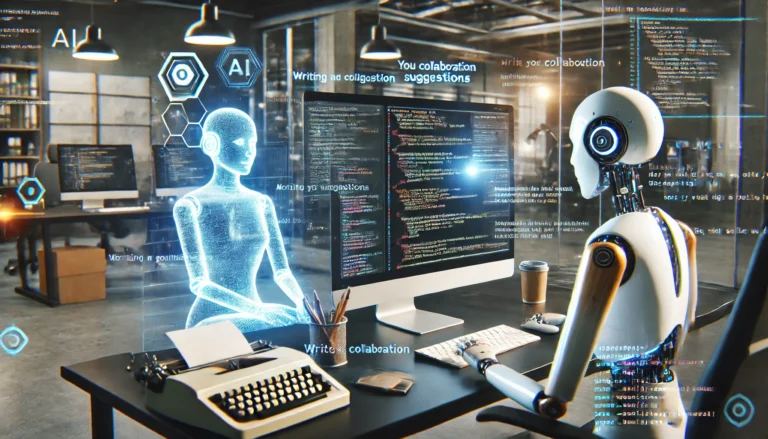As technology continues to evolve, so does the way we collaborate. OpenAI has recently introduced an innovative feature named “Canvas” that reimagines how users interact with ChatGPT for writing and coding projects. In this blog post, we will explore how Canvas works, its benefits, and how it aims to take collaboration with AI to the next level.
The Evolution of Collaboration: What is Canvas?
ChatGPT Canvas is OpenAI’s newly introduced interface for working alongside ChatGPT. Unlike the traditional chat format, ChatGPT Canvas opens up in a separate window, allowing users to interact with ChatGPT as they would with a creative partner, editor, or co-coder.
The goal of ChatGPT Canvas is not just about conversation but about creating, revising, and refining ideas in a visual and interactive environment.
This early beta version is now available for ChatGPT Plus and Team users globally, with plans to roll it out to Enterprise, Edu, and eventually Free users. With Canvas, OpenAI hopes to provide a more seamless experience, making it suitable for those who wish to work on detailed projects requiring iterative editing and ongoing improvement.
Why Canvas is a Game-Changer
For many, ChatGPT is already a helpful tool for generating ideas, drafting content, or solving coding issues. However, the chat interface has limitations when it comes to more complex projects that require frequent revisions and in-depth collaboration. Here’s why Canvas could revolutionize this experience:
- Real-Time Project Collaboration: ChatGPT Canvas offers an interface where you and ChatGPT can work side by side. This environment is well-suited for tasks that require both drafting and revising—be it a writing project or a coding one.
Keyword Use: ChatGPT Canvas makes it easy to implement focused keywords throughout your work by highlighting them in real-time. This feature ensures SEO optimization from the start.
Visual Clarity: ChatGPT Canvas includes visual cues and color-coded suggestions to help identify areas that need attention.
- Contextual Understanding: You can highlight specific parts of your text to instruct ChatGPT precisely on what you want to edit, much like a professional editor or reviewer. ChatGPT can then provide inline comments, suggestions, or rewrites based on the selected text.
- Shortcut Menu for Productivity: The Canvas interface features shortcuts that let users ask ChatGPT to adjust text length, debug code, polish content, or even change its reading level quickly. These features can help streamline the creative process, especially for users who have specific formatting or readability requirements.
Key Features of Canvas for Writing
Canvas redefines how users interact with ChatGPT by offering several unique features tailored specifically to the writing process:
1. Inline Editing Suggestions
Canvas can work like a copy editor, offering inline suggestions to improve clarity, flow, and engagement. It doesn’t stop at grammar and punctuation; it dives deep into the creative elements, making targeted recommendations.
2. Adjust Content Length and Complexity
Whether you’re drafting a short blog post or a lengthy report, Canvas can adjust the length of your content based on your needs. It can also adapt the reading level, whether you want a simple explanation for younger readers or something suitable for an academic audience.
3. Final Polishing
Canvas ensures that your content is publication-ready. It checks grammar, style consistency, and even provides a final polish to ensure your writing resonates with the target audience.
Coding with ChatGPT Canvas: A More Interactive Approach
Coding is often a more iterative process than writing. Debugging, rewriting, and optimizing code usually require several back-and-forth steps. Here’s how Canvas helps make coding with ChatGPT more effective:
1. Code Review and Improvement
Using Canvas, ChatGPT can give inline suggestions for improving code, similar to a code reviewer’s feedback. Whether you’re looking to simplify a function, remove redundancies, or follow best practices, Canvas can provide targeted edits to enhance the code’s quality.
2. Debugging Tools
Canvas offers shortcuts to help debug code by inserting print statements, adding comments, or detecting potential errors. This makes the debugging process smoother, especially for developers who need a quick way to identify issues without going through lines of code manually.
3. Code Porting
Need your Python script translated into JavaScript? Canvas can port your code to various popular programming languages, making it an efficient tool for developers who work across different tech stacks.
Training GPT-4o to Be a Better Collaborator
Canvas is built on GPT-4o, with a focus on training it to function as a creative and technical partner. The goal is to understand when and how to make edits—whether it requires targeted adjustments or a complete rewrite. This level of adaptability allows users to benefit from more precise, context-aware suggestions.
To accomplish this, OpenAI focused on several core areas:
- Triggering Canvas Appropriately: One of the challenges was to teach GPT-4o when to open Canvas. The model has been trained to recognize scenarios where Canvas can be helpful, such as detailed writing tasks or complex coding issues, while avoiding unnecessary disruptions for general Q&A interactions.
- Targeted Edits vs. Full Rewrites: When a user selects specific text in Canvas, the model knows to focus only on that part, making targeted edits. However, when no specific text is highlighted, it may propose a complete rewrite. This adaptability makes Canvas a unique tool for both writers and developers.
- Providing High-Quality Comments: For those looking to improve their skills, GPT-4o can provide detailed comments on code or writing—akin to receiving expert feedback. These comments have been tested and refined using human evaluations to ensure their quality.
The Impact of Canvas on Creative Workflows
The introduction of Canvas marks a significant change in how AI can assist with creative and technical projects. Its primary advantages lie in its ability to:
- Offer a more interactive, side-by-side collaboration experience.
- Make targeted edits or rewrites based on user needs, enhancing productivity.
- Provide precise, context-aware suggestions for both writing and coding tasks.
- Improve user autonomy by enabling direct editing, adding comments, and restoring earlier versions.
Looking Ahead: What’s Next for Canvas?
Canvas is still in its beta phase, but OpenAI has ambitious plans for its development. Future updates will include expanded capabilities for different types of users, deeper integration with other tools, and improved support for SEO-focused content creation. Enhanced transparency regarding AI changes during collaborative processes is also on the horizon. As OpenAI continues to gather feedback, users can expect Canvas to evolve into an even more powerful tool for both writing and coding.
The vision behind Canvas is to make AI a genuinely valuable partner—not just by generating content but by collaborating actively to refine and improve it. For anyone who wants to push the boundaries of creativity and productivity, Canvas promises an exciting glimpse into the future of AI-assisted work.
Conclusion
Canvas by OpenAI offers a new way to collaborate, whether you’re a writer, developer, or content creator. With its ability to provide inline suggestions, adjust complexity, debug code, and even port between programming languages, Canvas redefines what’s possible when working alongside AI. As it continues to evolve, Canvas has the potential to make AI not just a tool, but a true creative partner.



